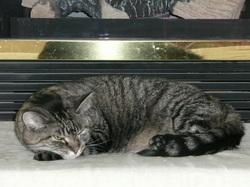
Even before the slot machines greeted me at the Vegas airport, I’d decided to never leave my hotel. That’s one of the great things about Vegas hotels—they have everything you need at your disposal: restaurants, salons, nightly shows and even a magic shop where I picked up a great box of tricks for my 8-year-old daughter.
After watching CSI re-runs with the new perspective of “Hey, I’ve been there,” my gaze landed on the Las Vegas magazine on my bureau. On the cover stood a woman in an elegant black gown with matching silk gloves and a caption that made my heart skip a beat: Titanic. The traveling exhibit had caught my attention months earlier, but I hadn’t been able to see it. Within minutes, I stepped out into the sunshine, hailed a taxi and headed for the Luxor. The exhibit eerily re-created the luxury ship so well, I vacillated between longing for such opulence and shuddering at the tragic end to so many lives. My boarding pass held the name of a real passenger, Thomas Drake Martinez Cardeza, a man returning from an African safari whose suite featured two bedrooms, a sitting room and a private fifty-foot promenade. At first, I thought, “Well, I’ll survive since I’m first class.”
I walked along a frigid wooden deck in a dark room to find individual stories interspersed between porcelain dishes, alligator pocketbooks, and spectacles recovered from the ocean floor. I read about a man’s possessions that went down with the ship, whose life was only spared because he’d been shanghaied before the Titanic disembarked. How lucky, I thought ironically. I read about a family that could’ve afforded first class cabins, but to save money, chose to stay in second class. I hope that decision didn’t cost them their lives, I thought. I read about a woman who felt her life was ruined because she lost her husband when the ship sank. I’d forgotten about the captain’s cry for “women and children first.” Maybe Thomas Drake Martinez Cardeza didn’t survive, after all. I shivered.
I definitely studied the list of those who died closely before I exited the exhibit.
After surviving one of the greatest shipwrecks of all time, I became bold enough to explore more of the city. I took in the impressive trapeze act at Circus, Circus and the Bellagio fountains, which danced to classical music. I walked along the strip, enjoying the spectacle of colored lights, pillars and roller coasters, which I’d only ever seen in pictures. An hour whizzed by and I was happy I’d dared to leave my hotel.
What surprised me the most about Vegas was how friendly the people were. Maria, the housekeeper at the Riviera, gave me a full-sized container of conditioner from her own locker because I’d forgotten mine at home (and wouldn’t let me pay her for it). An Ethiopian taxi driver insisted I take his bottled water when my sinus infection caused me to break into a coughing fit. The cashier at the 7-11, who sold me a postage stamp, made me laugh when he told me his tech-savvy little brother asked him how to address an envelope. Then the boy said, “Never mind. I’ll just Google it.”
So, thank you, Nevada’s City of Lights, for showing me there’s more to you than meets the eye. A few days later, when I returned to the piles of snow and freezing temperatures of Indiana, I missed the warmth of Vegas—in more ways than one.
Visit www.lasvegas.com to learn more about things to do on your Vegas vacation and visit www.RMSTitanic.net to see where you can experience history for yourself.
If you need a good book to read on the flight, check out www.karensnovels.com for “Happy Endings with a Twist.” Karen Lenfestey’s novel, A Sister’s Promise, has been called “intriguing, sometimes humorous, and heart-warming” and has sold over 40,000 copies at Amazon.









 RSS Feed
RSS Feed


